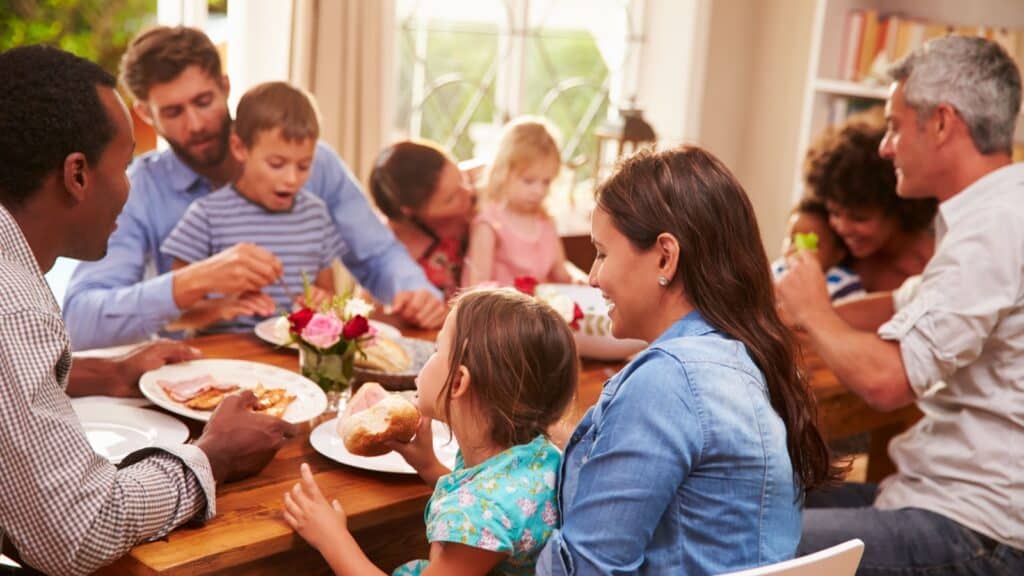What We Can All Learn From Polyamorous Parents
Experts on polyamory share insights around communication, community, and support that can be helpful to all parents.
It’s been 10 years since journalist Jennifer Senior observed in her book All Joy and No Fun: The Paradox of Modern Parenthood that, according to many studies, parents aren’t happier than the child-free “and in certain cases are considerably less happy.” Since then, it doesn’t seem like much has changed for parents.

According to a recent survey by the Pew Research Center, 62% of those polled said that being a parent has been somewhat harder than they expected, and 26%—mostly mothers—indicated that it’s been a lot harder than they expected.
Parents are dealing with more than ever before, yet all too often they believe that they alone are responsible for doing it all—managing their child’s care, development, and education with no outside help, family-friendly policies, or community support, says Dr. Dana Suskind, of the University of Chicago Medical Center. In her 2022 book Parent Nation: Unlocking Every Child’s Potential, Fulfilling Society’s Promise, she writes:
As parents, we (especially moms) have internalized this propaganda. Burdened by guilt, most are managing a delicate balancing act, struggling to make it work, yet forever feeling inadequate, unable to live up to the ideal we imagine we should achieve . . . society has abdicated its responsibility for all families. With the exception of the top 1 percent, our society makes raising children hard for everyone—and impossible for some.
Clearly, most if not all parents, no matter their socioeconomic status or education level, could use some help.
Of course, family-friendly government and workplace policies such as paid family leave, flexible work schedules, and access to high-quality, affordable child care would offer great relief to stressed-out parents. Still, policies only go so far. There are some things parents can do to not only help their children, but also help themselves.
There is one model that comes from a place that will seem unlikely to many people: polyamorous parents.
For the record, I’m not polyamorous, nor am I promoting polyamory. There are undoubtably as many bad poly parents as there are bad monogamous parents. Yet there’s no way to ignore the fact that by the nature of how they live, poly parents are different—and the difference has nothing to do with their sex lives.
In truth, most children don’t want to know anything about their parents’ sex lives. Many of us grew up thinking our parents “did it” as many times as there were children in the family because, ew. No one really wants to think of their parents as sexual beings.
And despite what many believe, polyamory isn’t just about sex. It’s a form of ethical non-monogamy that’s defined as having multiple intimate relationships—sometimes sexual or romantic, but not always—with the full knowledge and consent of everyone involved.
So, if polyamory isn’t just about sex, then what could monogamous parents learn from poly parenting? According to the experts, lots of things.
Honesty builds trust

Polyamorous people have to communicate—a lot.
In order to navigate agreements and explore boundaries while building intimacy, being honest with each other is essential. According to Elisabeth Sheff, who has studied polyamorous families for decades and is the author of The Polyamorists Next Door: Inside Multiple-Partner Relationships and Families, the kind of transparency that typically occurs in poly families can bring them closer together.
“The whole thing about polyamorous parenting is providing honest and age-appropriate information when the kids ask,” she tells me in a phone interview. “Polyamorous parents in their romantic relationships do a lot of truth telling to each other. It’s the fundamental basis of polyamory, one of the core values, to tell each other the truth about what you’re doing and to tell yourself the truth.”
This trickles down to their children.
Sheff says one thing many children in poly families have shared with her is that they appreciate that their parents can admit when they’re wrong and even apologize. Doing that sets the stage for the children to learn how to be accountable: “Yeah, people make mistakes. We screwed that one up. Sorry about that.”
That helps develops trust between parents and children, which helps children feel safe.
Children in poly families don’t get in trouble for asking questions, according to Sheff, which often happens in families with a more authoritarian parenting style. Because of that, they also are more likely to tell their parents the truth because they know it’s safe to be honest.
“Parents who model honesty and communication give their kids a great foundation,” writes Robyn Trask, the executive director and editor of the Loving More nonprofit and magazine:
Kids have amazing intuition and perception, often much more than people give them credit. When parents keep a secret from their child, I believe the child feels it. Kids, whose parents have shared their choices honestly and included poly partners in their family life, are amazing. They exude confidence, are honest and curious, are not afraid to ask questions, and seem to be interested in life beyond their peer group.
In her 2015 report on polyamorous parenting studies, “What About the Children?! Children in Polyamorous Families: Stigma, Myths, and Realities,” sexuality educator Jacki Yovanoff notes that the straightforward way poly partners talk to each other influences the way they talk to their children.
“The priority put on openness, honesty and emotional literacy can foster an environment where children develop a tendency for higher emotional intelligence,” she writes. It also can lead to “a higher degree of maturity, self-confidence and self-reliance, as well as great interpersonal skills.”
Of course, we can find these qualities, skills, and practices in many families, not just polyamorous ones. But the fact that so many poly families stress them creates a model that might inspire others, of creating a culture of open, honest communication in your family.
It takes a village
San Francisco was the first city in the United States to offer fully paid leave for new parents, including new adoptive parents, in 2016. And while the U.S. still doesn’t have a national paid leave policy, 13 states and the District of Columbia have passed paid leave policies for eligible workers.
Regardless of whether other states and localities follow their lead, there’s something missing from the discussion—what happens after the leave ends?
There’s a lot of caregiving that follows the first weeks, months, and years of a child’s life. According to a 2016 study, moms of middle-school-age children are even more stressed than exhausted new moms and more in need of support. Having more adults around can help poly parents share the burden.
“Pooling their resources also allows adults to have more personal time, work more flexible hours, and get more sleep because there are multiple people around to take care of the children,” Sheff writes. “Poly parents said that they felt more patient and had more energy for their children when they were well rested and had sufficient income—all of which benefitted their children.”
Help, rest, personal time—what harried parent wouldn’t appreciate that?
Beyond that, parents can learn and ask for advice from their partners and “metamours”—their partners’ partners, although it also can lead to more disagreements about how things should be handled.
“By having more input from more adults, parents learn really important parenting skills from each other,” Sheff tells me.
And children have other adults they can talk to besides their parents for different perspectives, who can act as role models and may remain in their lives even if those adults are no longer romantically involved with the child’s parents. “Sometimes kids don’t want to talk about something with their parent, but they do want to talk to a trusted adult,” Sheff says.
That’s what Benedict Smith experienced growing up in a poly family. He writes in Vice:
I got to speak to adults from all manner of varying backgrounds, whether they were my parents’ partners, or parents’ partners’ partners, or whoever. I lived with people who were straight, gay, bi, trans, writers, scientists, psychologists, adoptees, Bermudians, Hongkongers, people of wealth, and benefits claimants. Maturing in that melting pot really cultivated and broadened my worldview, and helped me become the guy I am today.
“It’s made me a more open and loving person,” one Reddit user writes. “I’m not afraid of being close to people because my parents were always very close with their friends. . . . I’m still quite close with a lot of them and consider them friends of mine outside of my parents[’] friendship with them and I also have a few more parental figures to choose from, meaning I can pick the best ones from each to try and emulate.”
Basically, both the parents and the children have a village.
The nuclear family isn’t working so great for us anymore. Parents and children could both benefit from what I call “carenting,” a modern-day form of alloparenting—“sharing and caring derived from the pooled energy” of a network of “grandparents, aunts, uncles, siblings, distantly related kin, and non-kin.” Poly parents are proof that “sharing and caring” can work.
Monogamous, heterosexual parents were once able to rely on extended family to help raise kids. For many, that’s not the case anymore. Polyamorous parents are pioneering one alternative that anyone can adopt: Create a village of loving, nurturing, and ongoing caregivers and mentors from various backgrounds for you and your children.
Learning to let go
Creating that village won’t work, however, unless parents—OK, mostly moms—allow other people to love their children. Sadly, that doesn’t always happen.
In her research on the relationship mothers have with the caregivers they hire, sociologist Cameron Lynne Macdonald, author of Shadow Mothers: Nannies, Au Pairs, and the Micropolitics of Mothering, says that in their desire to be their child’s primary attachment, some mothers will fire a caregiver after a year, so their child doesn’t get too attached. That not only deprives their child of a long-term, stable, and loving relationship, but also denies themselves the help they really need.
“The relationship between any working mother and the caretaker of her child involves some of the most intense, important, conflicted and complicated interactions a woman is ever likely to have,” writes Jessika Auerbach in her book And Nanny Makes Three: Mothers and Nannies Tell the Truth About Work, Love, Money, and Each Other.
“There’s a lot of resentment and envy for what people imagine to be this wonderful relationship where you hand everything over to this other person (the nanny). But at the same time, there’s disapproval, because you think the mother should be doing it all.”
Ideally, that doesn’t generally happen with polyamorous parents.
A common term in the poly community is “compersion”—the joy a person feels when they see their partner experiencing pleasure with someone else. It’s the opposite of jealousy. While it’s typically spoken of in terms of poly lovers, it translates to other people caring for and loving children.
“Compersion not only helps the family survive, but it’s good for the kid,” Sheff says.
Children in her studies have told her that they consider their parents’ long-term partners as trusted adults and turn to them for emotional support and practical assistance, even if they are no longer part of the polycule, a term to describe all the partners in the same polyamorous group.
“The sexual relationships among the adults are irrelevant to the adults’ relationships with the children. The adults’ relationships with the children exist fully outside the adults’ sexual relationships with each other,” she says.
How might that apply to you? Consider trying to let go of any jealousy you might have toward your child’s other caregivers, allow your children to love their caregivers, and support and encourage those bonds.
Connected even when apart
Sheff observes that it’s often the non-sexual, emotional connection that maintains a poly family for the long haul—what she calls “polyaffectivity.”
Even if there once was a sexual aspect of a poly parents’ relationship, they often keep an amiable connection if their relationship ends. This benefits their children.
“The end of sex does not have to mean end of relationship. Remaining friends is a real choice, and especially important when people have had children together,” she writes.
Removing the emphasis on sexuality creates a path for former partner parents to be friendly with each other so they can focus on cooperative co-parenting, she says. That’s essential because studies indicate that divorce per se isn’t the problem for children; conflict is.
Too often, the end of a romantic parenting relationship is considered a “broken” family or a “failed” relationship, but for poly parents it’s more about acknowledging that a relationship that used to work for the people involved isn’t working for them anymore. By shifting their focus to cooperative co-parenting, poly parents show their children that a healthy relationship isn’t just about love and sex; it’s about being kind and respectful.
The lesson for everyone else? If the relationship with your child’s other parent ends, be respectful, kind, and supportive to your former romantic partner so you can co-parent together without conflict and anger.
There isn’t a “right” way to be a good parent, although over the years there have been many different approaches to parenting, science-based and not. Still, most of us are aware of troubling ways to parent. Children have one essential need—to feel safe and secure, child development expert Nancy Carlsson-Paige shares with me. Tapping into the wisdom of poly parents just might offer a way to do that.
This article originally appeared on Greater Good, the online magazine of the Greater Good Science Center at UC Berkeley.
Greater Good magazine turns scientific research into stories, tips, and tools for a happier life and a more compassionate society.
Through articles, videos, quizzes, and podcasts, we bridge the gap between scientific journals and people’s daily lives, particularly for parents, educators, business leaders, and health care professionals.
Greater Good magazine is published by the Greater Good Science Center (GGSC) at the University of California, Berkeley. Since 2001, the GGSC has been at the fore of a new scientific movement to explore the roots of happy and compassionate individuals, strong social bonds, and altruistic behavior—the science of a meaningful life.







